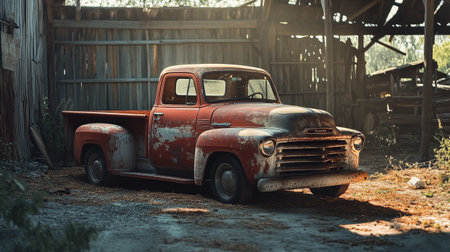Roots on the American Frontier
When we trace the journey of pickup trucks in America, their story begins far from modern highways or city streets. In the early 20th century, pickup trucks emerged as indispensable tools for farmers, ranchers, and builders carving out lives across the vast American frontier. More than just vehicles, these rugged machines embodied the nation’s enduring work ethic and the pioneering spirit of the open road. The first pickups were practical and straightforward—stripped-down chassis with wooden beds, designed to haul crops, livestock feed, and construction materials through fields and down dusty trails. They quickly became a symbol of self-reliance and resilience, reflecting the values that shaped rural communities. As homesteaders and small business owners relied on pickups to keep America moving forward, these humble workhorses took root in our collective consciousness, laying the foundation for a cultural icon that would evolve with each new generation.
Pickup Trucks in American Pop Culture
Across the decades, pickup trucks have transformed from simple tools of the trade to powerful icons in American pop culture. These vehicles aren’t just modes of transportation—they’re woven into the fabric of American identity, standing as symbols of freedom, rugged individuality, and family reliability. Hollywood blockbusters, country music anthems, and classic novels have all contributed to this legendary status.
Hollywood’s Favorite Workhorse
In cinema, pickups are often cast as more than background props; they become extensions of their characters. Whether it’s a battered Ford F-Series rumbling down a dusty road in a coming-of-age drama or a shiny Chevy Silverado symbolizing newfound success, these trucks reflect the journey and spirit of their drivers. The iconic image of a pickup racing against the sunset has come to represent the American pursuit of adventure and self-reliance.
Pickups in Music and Storytelling
Country music and Americana storytelling frequently celebrate pickups as symbols of authenticity and connection. Chart-topping songs by artists like Johnny Cash, Carrie Underwood, and Luke Bryan all feature pickups as metaphors for freedom and escape. Lyrics often recall memories made in the bed of a truck—first kisses, late-night drives, or hauling friends to the lake. In books and TV series alike, pickups frequently serve as the setting for pivotal family moments or life-changing decisions.
Symbolic Roles of Pickup Trucks
| Medium | Symbolic Meaning | Example |
|---|---|---|
| Movies | Adventure & Resilience | “Twister,” “No Country for Old Men” |
| Music | Freedom & Escape | “Drive (For Daddy Gene)” by Alan Jackson |
| Lifestyle Stories | Family & Community Reliability | “Friday Night Lights” (TV Series) |
The Modern Pickup: A Cultural Bridge
As pickups evolved into luxury vehicles equipped with green technology and sustainable materials, their role in pop culture has also shifted. Today’s trucks bridge tradition with innovation: they still evoke nostalgia for open roads and simpler times but now also appeal to eco-conscious families seeking both comfort and responsibility. This enduring cultural presence ensures that pickups remain not only practical choices but also lasting emblems of American dreams—adaptable, inclusive, and always ready for the next adventure.
![]()
3. Technological Advancements and Design Evolution
Over the decades, American pickup trucks have undergone a remarkable transformation, evolving far beyond their utilitarian roots. In the early days, pickups were designed with simplicity and durability in mind—basic interiors, minimal creature comforts, and straightforward mechanics made them the workhorse of choice for farmers, builders, and small business owners. However, as consumer expectations shifted and technology advanced, so too did the modern pickup.
Today’s trucks are showcases of automotive innovation. Advanced safety features such as adaptive cruise control, lane-keeping assist, blind-spot monitoring, and automatic emergency braking have become standard or widely available across most models. These upgrades not only enhance driver confidence but also reflect a growing focus on family use and everyday commuting.
The evolution is equally evident in comfort and convenience. Plush leather seating, heated and ventilated seats, panoramic sunroofs, and customizable digital displays are now common options—features once reserved for high-end sedans or SUVs. Enhanced cabin insulation and sophisticated climate control systems ensure that even long road trips or tough job sites can be tackled in comfort.
Performance has also seen a dramatic leap forward. Modern powertrains deliver impressive horsepower and torque while still meeting stricter emissions standards. Innovations like turbocharged engines, hybrid systems, and even fully electric drivetrains are redefining what it means to drive a pickup in America. Many models offer multiple drive modes tailored to various terrains, integrating smart suspension systems for smoother rides both on- and off-road.
This fusion of robust capability with state-of-the-art technology demonstrates how American pickups have evolved to meet the diverse needs of today’s drivers—balancing tradition with innovation while paving the way for a more sustainable future.
4. Rise of the Luxury Pickup
The American pickup truck has undergone a dramatic transformation over the past few decades, especially with the emergence of luxury models. No longer just utilitarian workhorses, pickups have evolved to meet the growing desires of consumers seeking comfort, technology, and prestige in their vehicles. This shift reflects broader trends in American lifestyles and priorities, as well as advances in automotive design and sustainability.
High-End Amenities Enter the Mainstream
Starting in the late 1990s and accelerating into the 21st century, major automakers began outfitting pickups with features once reserved for premium sedans and SUVs. Heated and ventilated leather seats, advanced infotainment systems, panoramic sunroofs, adaptive cruise control, and even massaging seats became available in top-tier trims. These amenities turned pickups into versatile vehicles that could handle both job sites and night-outs on the town.
Comparing Workhorse vs. Luxury Pickups
| Traditional Workhorse Pickup | Luxury Pickup | |
|---|---|---|
| Primary Use | Towing & Hauling | Lifestyle & Comfort |
| Interior Materials | Vinyl or Cloth Seats | Premium Leather & Wood Accents |
| Technology | Basic Audio & Controls | Touchscreen Navigation, Premium Sound, Connectivity Features |
| Sustainability Features | Conventional Engines Only | Hybrid Powertrains, Eco-Friendly Materials (in some models) |
| Price Range (2024) | $30,000 – $45,000 | $60,000 – $100,000+ |
Lifestyle-Focused Models Reflecting Consumer Trends
The rise of luxury pickups mirrors shifts in American consumer values—drivers want vehicles that serve multiple purposes: commuting in style, weekend getaways, family road trips, or even camping adventures. Automakers responded by launching specialized models like the Ford F-150 Limited, GMC Sierra Denali, and Ram 1500 Limited. These trucks come equipped with advanced safety features, Wi-Fi hotspots, power tailgates, and interior finishes that rival luxury SUVs.
Sustainable Luxury: A Growing Consideration
The evolution toward upscale pickups isn’t just about comfort—it’s also about responsibility. Increasingly, buyers are looking for options that balance power with sustainability. Some high-end trucks now feature hybrid or electrified powertrains and use recycled or renewable materials inside their cabins—a nod to the growing green energy movement and a more eco-conscious America.
5. Sustainability and Green Innovations
In recent years, American pickup trucks have undergone a remarkable transformation, embracing sustainability and cutting-edge green technologies. As environmental awareness grows and regulatory pressures mount, automakers are pivoting toward electric pickups and innovative eco-friendly solutions that redefine what it means to drive a truck in the 21st century.
Electric Pickups: Leading the Charge
The introduction of all-electric models like the Ford F-150 Lightning, Chevrolet Silverado EV, and Rivian R1T marks a new era for the industry. These vehicles combine traditional pickup power and utility with zero-emission performance, offering impressive towing capacity and range without sacrificing environmental responsibility. The F-150 Lightning, for example, leverages Ford’s legacy while pushing boundaries with features like an onboard generator and intelligent power management.
Eco-Friendly Materials and Manufacturing
Beyond electrification, manufacturers are investing in sustainable materials and greener production processes. Recycled aluminum, bio-based plastics, and energy-efficient assembly lines are becoming standard. These initiatives reduce each truck’s carbon footprint—from factory floor to open road—demonstrating the industry’s commitment to holistic sustainability.
Impact on the Green Energy Movement
The rise of green pickups resonates far beyond dealership lots. By normalizing electric trucks among American consumers—who have long favored powerful vehicles—automakers help accelerate the nation’s shift toward renewable energy and cleaner transportation. With charging infrastructure expanding coast to coast and more models set for release, American pickups are now at the forefront of the country’s green energy revolution.
6. Cultural and Economic Impact
Pickup trucks are more than just vehicles in America—they’re woven into the very fabric of national identity, reflecting values of resilience, independence, and community. Over decades, pickups have evolved from utilitarian workhorses to symbols of status and innovation, influencing not only how Americans work but also how they live and connect with one another.
The American Identity on Four Wheels
For many, owning a pickup is a rite of passage—a statement about practicality and pride. Whether seen at construction sites or parked at tailgate parties, pickups represent versatility and the enduring spirit of American ingenuity. Their robust presence in rural landscapes and urban driveways alike speaks to their universal appeal, bridging diverse communities across the country.
Economic Backbone
Pickups play a pivotal role in the U.S. economy. They are essential for small businesses, farmers, tradespeople, and those whose livelihoods depend on reliable transportation. The automotive industry’s focus on pickups supports millions of jobs, from manufacturing plants in Detroit to dealerships nationwide. As new models integrate green technologies and sustainable materials, they also drive investment in renewable energy sectors—further contributing to economic growth while aligning with a cleaner future.
Building Community Connections
Beyond job sites, pickups have become integral to American leisure and social life. From hauling camping gear for weekend getaways to serving as the centerpiece at community events, these vehicles foster connections through shared experiences. They symbolize readiness for adventure and the ability to support friends and neighbors when needed—values that resonate deeply within American culture.
A Future Rooted in Tradition and Innovation
As pickups transition toward electric powertrains and eco-friendly features, they continue to shape not only the roads but also the hearts of Americans. This evolution honors tradition while embracing sustainability—ensuring that pickups remain both an economic force and a cultural icon for generations to come.


